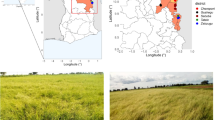Abstract
Triploid Fritillaria camschatcensis (L.) Ker-Gawler (2n = 3x = 36) is a wild species growing in the low-lying areas of Hokkaido Island, Japan, including the Sapporo campus of Hokkaido University. Many F. camschatcensis plants grew on the campus about a century ago, but we seldom find the plants nowadays and so a project to restore this species is being planned. Because preservation of genetic diversity and composition in populations has become a major target of conservation, this study compared variation in the F. camschatcensis population on the Sapporo campus with that in two other populations in Hokkaido. Phenetic variation assessed by 57 randomly amplified polymorphic DNA markers showed that the three populations were significantly distinct from each other; analysis of molecular variance showed 64.3% of variation (P < 0.001) existed among the three populations. Comparison of phenetic diversity on the Sapporo campus population with that in the two other populations showed that the Sapporo campus population contained large genetic variation despite reduced plant numbers. These results indicate that multiplying F. camschatcensis individuals on the Sapporo campus is adequate to restore the Sapporo campus population because this population contains enough genetic diversity, and that transplanting from other populations should be avoided so as not to introduce different genotypes into the campus. These results will be used to design the restoration strategy.


Similar content being viewed by others
References
Abe H, Nakano M, Nakatsuka A, Nakayama M, Koshioka M, Yamagishi M (2002) Genetic analysis of floral anthocyanin pigmentation traits in Asiatic hybrid lily using molecular linkage maps. Theor Appl Genet 105:1175–1182
Asano Y, Tsukamoto Y (1990) Fritillaria L. In: The Grand dictionary of horticulture, vol 4. Syogakkan, Tokyo, pp 271–274 (in Japanese)
Excoffier L, Smouse PE, Quattro JM (1992) Analysis of molecular variance inferred from metric distances among DNA haplotypes: application to human mitochondrial DNA restriction data. Genetics 131:479–491
Harada M (1966) Flash back to the period when the circle was established. In: The 60th memorial bulletin of Kuroyuri Art Circle, Sapporo. pp 3–5 (in Japanese)
Hogbin PM, Peakall R (1999) Evaluation of the contribution of genetic research to the management of the endangered plant Zieria prostrata. Conserv Biol 13:514–522
Honjo M, Ueno S, Tsumura Y, Washitani I, Ohsawa R (2004) Phylogeographic study based on intraspecific sequence variation of chloroplast DNA for the conservation of genetic diversity in the Japanese endangered species Primula sieboldii. Biol Conserv 120:211–220
Honjo M, Kitamoto N, Ueno S, Tsumura Y, Washitani I, Ohsawa R (2009) Management units of the endangered herb Primula sieboldii based on microsatellite variation among and within populations throughout Japan. Conserv Genet 10:257–267
Ito K, Yamori K (1963) Fritillaria camschatcensis society in the deciduous broad-leaved forest, near Abashiri city, Hokkaido, Japan. Jpn J Ecol 13:184–188
Kéry M, Matthies D, Spillmann H-H (2000) Reduced fecundity and offspring performance in small populations of the declining grassland plants Primula veris and Gentiana lutea. J Ecol 88:17–30
Kihara H, Koyama M (1954) Offspring obtained by self-pollination of Lycoris radiata Herh., a triploid species. Jpn J Genet 29:161–162 (in Japanese)
Matsuura H (1934) On karyo-ecotypes of Fritillaria camschatcensis (L.) Ker-Gawler. J Faculty Sci, Hokkaido Imperial Univ, Ser. 5, Botany 3:219–232
Naruhashi N (1973) Fritillaria L. Shinkaki 78:27–31 (in Japanese)
Nei M, Li WH (1979) Mathematical model for studying genetic variation in terms of restriction endonucleases. Proc Natl Acad Sci USA 76:5269–5273
Okutsu K, Kuramoto N (1999) Analysis of genetic variability of Castanopsis sieboldii (Makino) Hatusima for transplant to Mt. Atago in Izu Oshima. J Jpn Inst Landsc Archit 62:533–538 (in Japanese)
Plant problem advisory committee (2002) Proposal of biodiversity-cared policy for revegetation technology. J Jpn Soc Reveget Tech 27:481–491 (in Japanese)
Robichaux RH, Friar EH, Mount DW (1997) Molecular genetic consequences of a population bottleneck associated with reintroduction of the Mauna Kea silversword (Argyroxiphium sandwicense ssp. sandwicense [Asteraceae]). Conserv Biol 11:1140–1146
Saito K (1975) Studies on the occurrence of polyploidy and its contributions to the flower plant breeding. XII. On the nature and sterility in the spontaneous triploid cultivares of Rhodohypoxis baueri Nel. Jpn J Breed 25:355–362 (in Japanese with English summary)
Schneider S, Roessli D, Excoffier L (2000) Arlequin: a software for population genetics data analysis. Ver 2.000. Genetics and Biometry Lab, Department of Anthropology, University of Geneva, Switzerland. http://lgb.unige.ch/arlequin/
Shimizu T, Hatanaka Y, Zentoh H, Yashima T, Kinoshita E, Watano Y, Shimizu T (1998) The role of sexual and clonal reproduction in maintaining population in Fritillaria camtschatcensis (L.) Ker-Gawl. (Liliaceae). Ecol Res 13:27–39
Shimizu T, Umebayashi M (1995) Supplement to “underground organs of herbaceous angiosperms” 1. Annual report botanic garden, Faculty of Science, Kanazawa University 18:1–6 (in Japanese with English summary)
Yamagishi M, Abe H, Nakano M, Nakatsuka A (2002) PCR-based molecular markers in Asiatic hybrid lily. Sci Hortic 96:225–234
Yamagishi M, Matsumoto S, Nakatsuka A, Itamura H (2005) Identification of persimmon (Diospyros kaki) cultivars and phenetic relationships between Diospyros species by more effective RAPD analysis. Sci Hortic 105:283–290
Young A, Boyle T, Brown T (1996) The population genetic consequences of habitat fragmentation for plants. Trends Ecol Evol 11:413–418
Acknowledgments
The authors offer special thanks to Ms M. Yonaha, Ms S. Kuroda, and Ms Y. Takeda, Sapporo City, and Mr. K. Niioka, Shiraoi Town, for helpful support during plant collection. Thanks are also due to Mr. S. Tanaka of the Kuroyuri art circle for recommending us to start this research.
Author information
Authors and Affiliations
Corresponding author
Additional information
This paper is dedicated to the centennial anniversary of the Kuroyuri art circle of Hokkaido University.
Rights and permissions
About this article
Cite this article
Yamagishi, M., Nishioka, M. & Kondo, T. Phenetic diversity in the Fritillaria camschatcensis population grown on the Sapporo campus of Hokkaido University. Landscape Ecol Eng 6, 75–79 (2010). https://doi.org/10.1007/s11355-009-0084-5
Received:
Revised:
Accepted:
Published:
Issue Date:
DOI: https://doi.org/10.1007/s11355-009-0084-5




